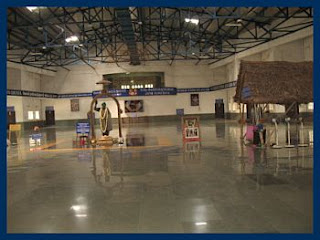As of this time Arunachala is not one of the 'sacred places' referred to in the various interlinking campaigns currently underway to 'Save our Holy Land'. However there are several sites in India which are already included in this alliance of religion and conservation. To read the full report prepared in collaboration with WWF, Equilibrium, and Alliance of Religions and Conservation (ARC) please download:

http://www.arcworld.org/downloads/WWF%20Beyond%20Belief.pdf
Save Our Holy Land
Hundreds of thousands of sacred places around the globe are to be linked together in a new UN-backed network to try to preserve the world's fast-disappearing wild species.
The sites range from Jerusalem's Garden Tomb; where more than 3,000 people gathered today to celebrate Easter; to "skull caves" in Kenya, from a Mongolian mountain revered as a living God to a "spiritual park" in the Peruvian Andes.
Last week the United Nations Development Programme joined the world's main religions and leading conservation organisations in an effort to protect them from development or destruction. They plan to set up a new internationally recognised designation along the lines of Unesco's World Heritage sites.
The world's religions are among the planet's biggest landowners. "Between them," a new Atlas of Religion concludes, "they own over 7% of habitable land of the planet." And their specially sacred sites are usually havens of wildlife because they have been safeguarded by spiritual traditions or taboos.
But now, as the power of religion fades and economic pressures increase, many of the sites are in danger. The new campaign, pearheaded by the Alliance of Religions and Conservation (ARC), set up by Prince Philip in 1995, aims to beat off threats, preserve new sites and revive sacred places that have already been despoiled. Prominent supporters include the Eastern Orthodox patriarch Bartholomew I and Nambaryn Enkhbayar, the President of Mongolia.
Martin Palmer, who heads ARC and is one of the authors of the atlas, just published by Earthscan, cites the Garden Tomb as one model of what can be done. The site owes its origin to a visit to Jerusalem by General Gordon, later killed in Khartoum. Unlike most scholars, the Victorian general refused to believe that the Church of the Holy Sepulchre stands on the site where Christ was buried, on the grounds that it was in Jerusalem, instead of outside; doubtless not realising that the city would have grown in the intervening 18 centuries.
Instead he found a first-century tomb near a rocky crag which looked to him as if it could be "the place of the skull" identified in the New Testament as the site of the crucifixion, and decided that it must the right place. Believers planted the land around it with flowers and trees mentioned in the Bible and it is now a valued wildlife site.
Similarly, Mr Palmer says, the Baha'i faith has created an extraordinary series of hanging gardens on Mount Carmel, most famous for Elijah's confrontation with the prophets of Baal in the Old Testament.
The oak forests of Mount Tabor have been preserved because it is owned by the Catholic Church, and in Lebanon Hizbollah has joined a Christian drive to preserve the "Valley of the Saints", where the persecuted have sought sanctuary for 1,500 years. Mr Palmer even believes that the campaign could help to revive the River Jordan whose "deep and wide" waters have now been so diverted for agriculture and housing that they are now little more than a trickle of sewage.
But the campaign will stretch far wider than the Holy Land and involve a total of 11 major faiths and 300 different traditions within them. In Cambodia, for example, thousands of trees have been ordained as Buddhist monks and wrapped in saffron monastic robes; to try to protect them from loggers.
In Mongolia, Bogd Khan, revered as a living deity, is the world's oldest protected mountain, and holy scripts are being translated to try to identify other sacred sites. Taboos surrounding Kenyan caves, where the Taita tribe places the skulls of important ancestors, have preserved the country's last major stand of tropical rainforest, famous for its 350 species of birds. But it is now threatened by logging and charcoal burning.
Conservationists hope that the forest might be saved by ecotourism, but in Peru, less sensitive visitors, flocking from Machu Picchu, are endangering the Andean Vilcanota Spiritual Park.
In Britain, contaminated land has been reclaimed for Birmingham's Sri Venkateswara Balaji Temple, the first Hindu shrine of its kind in Europe. And 6,000 churches have agreed to turn graveyards into wildlife refuges by banning pesticides.
Martin Palmer calls the world's sacred sites "the largest as yet unprotected network of pristine areas on the planet". He believes that by giving them an official designation he will make it much harder for them to be damaged.
The campaign is starting pilot schemes in Lebanon, Ethiopia and elsewhere, and hopes to have official designations in place within five years.
[By Geoffrey Lean and Jude Townend
The Independent U.K. (8 April 2007)]



































